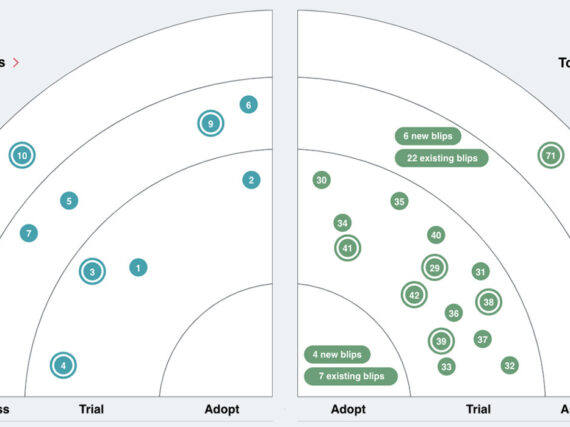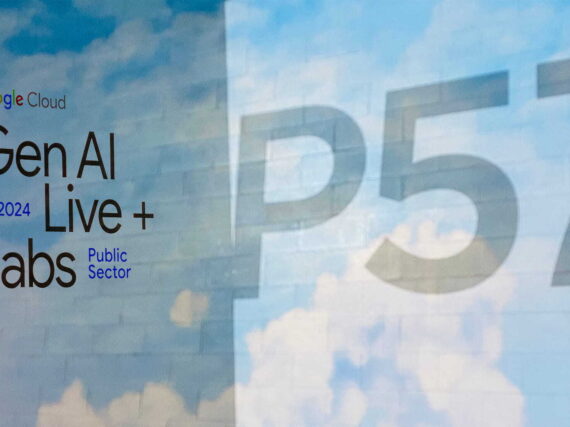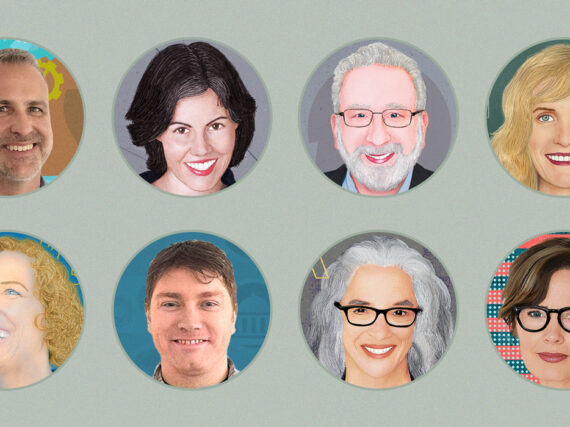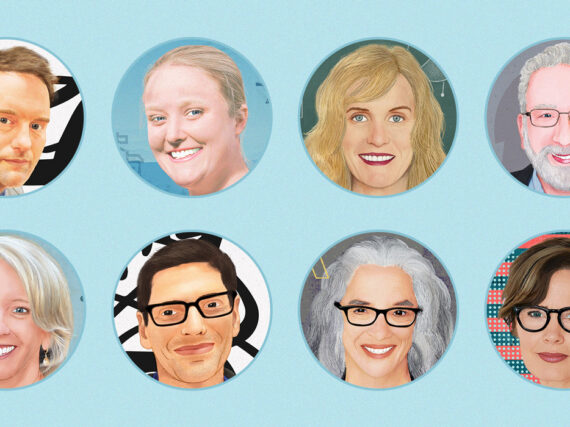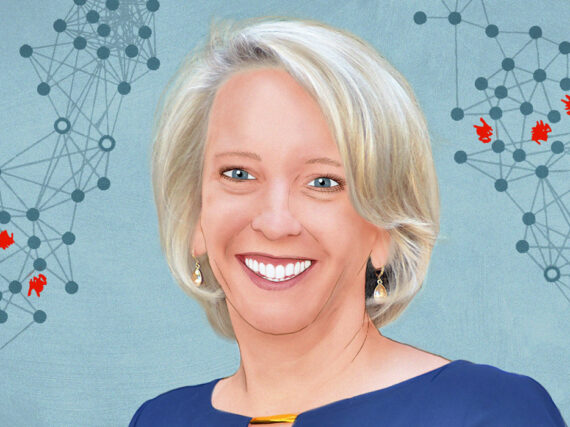Books and movies allow us to try on different characters and lives, and science fiction, especially, lets us slip into various alternative futures for humanity. We get to see if a totalitarian society like Orwell’s 1984 is better or worse than the test tube humans of Huxley’s Brave New World, or if the utopia in Lowry’s The Giver is really preferable to a dystopia.
Living through such scenarios in a narrative is similar in part to the work being done by the Institute for Alternative Futures (IAF) on the Human Progress and Human Services (HPHS) 2035 project. Four scenarios, or “stories describing how the future may unfold” were developed by IAF to help those working in HHS try on, and plan for, the futures that seem most probable for them.
We recently attended an American Public Human Services Association (APHSA) webinar that discussed IAF’s interesting project. This crystal ball, if you will, is one meant to help HHS agencies embrace the future with confidence. As a vendor in the human services domain, we wanted to share these unique insights with our clients.
What is the HPHS 2035 project?
With funding from the Kresge Foundation, the IAF used scenario planning to create alternative futures for human services programs. The scenarios detailed four possible outcomes ranging from Challenging (desperate), to Expectable (conventional), and Visionary (surprising).
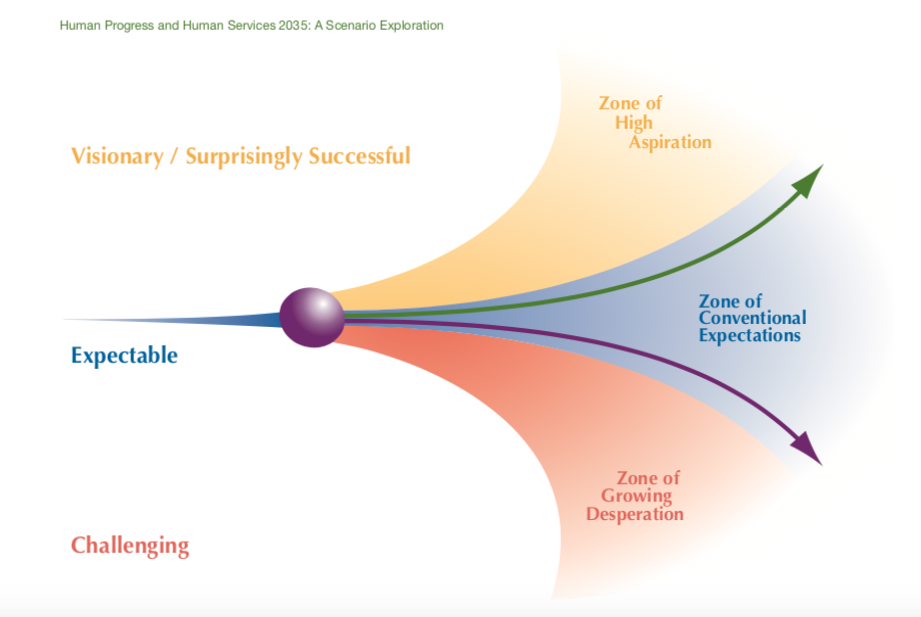
The following scenarios are detailed in The Human Progress and Human Services 2035 National Report:
- Scenario 1: Reductions and Rebounds (Expectable)
The first scenario is “expectable” or “most likely” given current trends. It assumes a period of likely human service cuts during the 2017-2021 Administration, with rebounds in the 2020s, as well as the evolution of human service delivery, automation and the use of intelligent agents in all sectors of the economy along with expectable job loss. - Scenario 2: Navigating Unending Challenges (Challenging)
The second scenario is challenging and considers some key things that “could go wrong” (including another Great Recession, funding cuts). - Scenario 3: Building Human Potential (Visionary)
The third and fourth scenarios are visionary. The third explores human progress in attitudes; technology including “abundance advances,” and policy – particularly a Guaranteed Basic Income. - Scenario 4: Thriving Communities (Visionary)
The fourth explores surprisingly successful changes in attitudes, a living minimum wage, technology including job loss to automation, policy transformations, and “abundance advances”.
“The IAF approach to scenarios is what we call aspirational futures,” Clem Bezold, Chairman and Senior Futurist at IAF, detailed during the webinar on February 20, 2019. “First you need to look at what’s most likely or expected (that center zone of conventional expectation). Then you need to ask, what could go wrong, what challenges does the community face (in the lower zone of growing desperation)? The third zone (of high aspiration), asks the question, what would be surprisingly successful? What would be a visionary state or endpoint, and what would be the path to that?”
“The effort is intended to engage the human services community in participatory futures as a series of events,” Bezold says. “They can use the scenarios to facilitate their preparation, imagination, and inspiration so that the community can then better prepare for and create the future, particularly by pursuing the preferred futures.”
Driving forces
A combination of human progress, human needs, and human services play out in different ways in each scenario to produce different outcomes. The following are the driving forces that are factored in the forecasts, as noted in the HPHS 2035 report:
- Job loss to Automation – between 9% to 47% of U.S. jobs could be lost to automation by 2030 (included in all Scenarios).
- Abundance Advances – a cluster of technologies that, if applied appropriately can lower the cost of living by providing in-home and in-community production of food, energy, and many home goods (in Scenarios 3 and 4).
- Options for Increasing Low-income Housing Stock – options include expanded government funding; increasing neighborhood density; encouraging Accessory Dwelling Units (ADUs); low-cost 3D printed homes (various options across the Scenarios).
- Guaranteed Basic Income – faced with permanently high unemployment, a Guaranteed Universal Basic Income would give $12,000 a year to each adult and $4,000 for each child (in Scenario 3 only).
- The Human Services Value Curve – a vision for the human services field.
- Equity Rising – the transformative influence of equity as a value and attitude shift affecting policy, personal, and neighborhood political decisions.
Working in the communities
IAF worked with eight communities around the country to develop the scenarios. Community and human service leaders from these areas were able to try the scenarios on for size as they considered their current and future goals.
- Cities: Memphis (TN), Richmond (VA), and San Antonio (TX)
- Counties: Jefferson County (CO), Montgomery County (MD), and San Diego County (CA)
- States: Connecticut, and Mississippi
For Bezold, the takeaways included the following insights:
- “In the climate and environmental arena, all communities over the next 15 years will face extreme challenges. The question in developing these scenarios, is what are the likely ones in this community or this state?”
- “A huge factor in the future will be what degree of job loss to automation occurs. But there’s also technology and communication advances….Our homes will be smarter, our cities will be smarter. Artificial intelligence will be driving those applications, but it will also be displacing jobs.”
- “There’s the possibility that a series of technologies could lower the cost of living and make people more independent. Those include low-cost energy production and storage, 3-D printing or in-community manufacturing, and home and community food production, all serious prospects for lowering the cost of living.”
Health and Human Services
IAF also looked at how the different futures would effect specific human services. Bezold noted some of the following considerations:
Aging Services
“By 2035 there will be more people over 65 than under 18, and the ratio of family and friends that act as caregivers will drop from 7/1 to 4/1).”
Behavioral Health
“What will be forcing or shaping the need for behavioral health, such as adverse childhood experiences, poverty, and so forth? How soon, and how well will artificial intelligence be applied, and how long before we have virtual counsellors providing effective behavioral health care?”
Children, Youth, and Family Services
“When big data is applied, what and how will it take shape, and what will prevent restrictive applications?”
Disability Services
“The greatest cause of disability will be the growth of Alzheimers and diabetes, but to what degree will substance abuse effect that? Simultaneously, there’s great promise for breakthroughs related to disabilities with prosthetics.”
Housing
“The forecast is that demand for low income housing will continue to outstrip supply in most communities. Will the federal funding cuts we are experiencing now rebound in 2020s? Can communities shift from NIMBY (not in my backyard) to YIMBY (yes, in my backyard)? How will tech effect home construction? For example, the first $10K home was 3D printed and built in 24 hours in Austin to meet city codes.”
Income Supports
“Regarding TANF, there’s a huge question given job loss and automation whether we will change our attitudes and take “temporary” out of the names of those types of programs. And will we establish a guaranteed basic income? If we do, we’ll need to change our sense of personal meaning and contribution, and say that raising children and taking care of others is a significant contribution.”
“Human services will play a role in shifting attitudes. Furthermore, abundance advances may require new policies and support by human services to enable them to actually play the role of lowering the cost of living for low income families.”
More info
As Bezold says, the question for the scenarios is, how will they play out? What forms will they take? Each community or agency must step into these alternative futures, like stepping into a book, to answer this question for themselves.
To this end, the IAF provides a scenario workshop toolkit that enables organizations and communities to chose a set of scenarios and use them to explore the implications. They can do their own scenario workshop and develop recommendations based on their findings.
Webinar #2 – “City, County and State Lessons from the Human Services 2035 Effort” will present the experiences of three state local efforts, San Antonio Texas, Richmond, Virginia, and State of Connecticut.
Wednesday, March 6, 1:00 PM – 2:00 PM, ET
Webinar #3 – “Stepping into the Human Services 2035 Scenarios” will summarize the recommendations that emerged from these efforts and present the highlights of the national scenarios.
Wednesday, March 27 | 1:00 PM – 2:00 PM, ET
“Think about life 20 years ago, before the internet, before social media, well, we’ll see that same degree of change by 2035,” Bezold says. “We sit at the verge of major transformations in all areas of policy.”
It’s important that we start looking now at how we want to get from here to there. We’ll be doing a follow up on this post after the next two webinars. Stay tuned for more insights from the future.
Learn more
- The Human Progress and Human Services 2035 National Report
- Tech Forecast for Health & Human Services by Ravi Jackson



